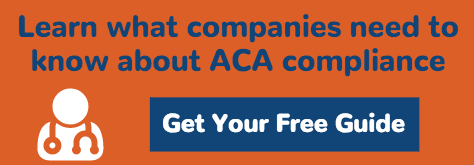Editor's Note: Since the publishing of this article, the IRS and U.S. Treasury extended reporting deadlines for ALEs filing certain forms related to the ACA, including Form 1094-C. The new deadlines for employers to file Form 1094-C are May 31, 2016 if filing by paper and June 30, 2016 if filing electronically. For more information, please read the IRS Notice 2016-4.
As the end of 2015 draws near, offices in the U.S. buzz with talk of open enrollment and ACA compliance. Whether it’s what employers should be tracking for ACA or what tools you need to do it, there’s a lot to cover with the Affordable Care Act.

A huge part of complying with the ACA will be the actual reporting and filing—the proof employers did what they should in 2015. Every Applicable Large Employer (ALE) will be required to follow the proper instructions for filing 1094-C with the IRS starting at the beginning of 2016. Is your office prepared to correctly distribute, complete, and file the proper IRS forms? If you want your business to be ACA compliant (and avoid major financial penalties), you need to know about these forms.
Let’s review some important information and frequently asked questions about Form 1094-C. Who needs to file, why file, when to file, and what revisions have been made are all important questions we will cover in the following 1094-C instructions.
Who needs to file Form 1094-C for 2015?
According to the IRS, Applicable Large Employers (ALE) with 50+ full-time and full-time equivalent employees in the previous year must file one or more Forms 1094-C and a Form 1095-C for each employee who was a full-time employee for any month of the calendar year. Remember that it does not matter how your company qualifies full-time employees, the ACA’s standards apply to all employers. Determine if you’re an ALE here.
What’s the purpose of Form 1094-C?
Under Code sections 6055 and 6056, ALEs must use Form 1094-C to report required information about whether or not the ALE offered affordable minimum essential health coverage (MEC) and enrollment in minimum essential health coverage for eligible employees. Form 1094-C will transmit forms 1095-C to the IRS.
Forms 1094-C and 1095-C will be used to determine whether an employer will be penalized for noncompliance. This penalty will require payment under the Employer Shared Responsibility provisions under section 4980H. These forms will also determine employees’ eligibility for the premium tax credit.
What determines if health coverage is affordable?
Health coverage is affordable if the amount charged by the employer for employee self-only coverage does not exceed nine and a half percent of the employee’s W-2 wages, pay, or the federal poverty level for 2015.
What information will be reported on Form 1094-C?
Employers will report the following on Form 1094-C for 2015:
- The employer’s name, employer identification number, and contact information
- The total number of Forms 1095-C filed (based on number of full-time equivalent employees during 2015 and any non-full-time equivalent employees who did enroll in the employer’s self-insured health plan.)
- Proof by month as to whether the employer offered its full-time equivalent employees (and dependents) the opportunity to enroll in minimum essential health coverage
- The number of full-time equivalent employees for each month of the calendar year 2015
- The total number of employees for each month for the calendar year 2015
- Any special rules or transition relief that applies to the employer
- The names and employer identification numbers of other employers that are in a controlled group or affiliated service group with the employer
What revisions have been made to the Form 1094-C for 2015?
In September 2015, the IRS issued the final revisions of Forms 1094 and 1095. The final revisions discuss the new increased penalties for failure to file statements and the relief granted for the 2015 tax year.
Penalties for failure to file complete and accurate forms by the form due date will be $250 per form, not to exceed $3 million (increased from $100 per form, not to exceed $1.5 million).
It’s important to note that while many ALEs with fewer than 100 full-time equivalent employees are generally eligible for transition relief, they are still required to file Forms 1094-C and 1095-C for the calendar year 2015 and subject to penalties for failure to file forms.
The revision also gives a heads-up to employers that in the future, the 9.5% calculation safe harbors may be indexed for inflation similar to premium tax credit eligibility.
Additionally, the 2015 Form 1094-C moved line 19 (reads, “Is this the Authoritative Transmittal for this ALE Member?”) into Part I of the form to allow for an entry in the “All 12 Months field” in Part III, line 23, column (b) Full-Time Employee Count for ALE Member.
When do employers need to file Form 1094-C for 2015?
Filing for the previous calendar year is due on February 28 (paper filing) and March 31 (electronic filing) UNLESS:
- The date falls on a weekend (Saturday or Sunday).
- The date falls on a legal holiday.
If a due date falls on one of the aforementioned days, the due date defers to the following business day. A business day, according to the IRS, is any day that is not a Saturday, Sunday, or legal holiday.
Because of weekends and leap year in 2016, the paper filing deadline is unique. Fortunately, we have a formula to determine due dates, so we know the deadlines will be as follows for the 2015 tax year:
- Monday, February 29, 2016 if filing on paper
- Thursday, March 31, 2016 if filing electronically
How to file for an extension for Forms 1094-C
If you would like an extension to file forms with the IRS, submit a Form 8809 on or before the due date of the return for an automatic extension. This form does not require a signature. For an additional 30-day extension, the filer or an authorized agent must sign the form.
How to file Form 1094-C
The IRS strongly encourages a detailed review of instructions for 1094-C before completing the forms as well as a thorough evaluation of all forms before submission. Employers may file on paper or electronically, though some restrictions apply.
Instructions for 1094-C Paper filing & Electronic filing
The IRS encourages all employers to file electronically if possible. However, if any employer must file 250 or more of a single type of form, the employer is required to file electronically. This requirement applies separately to each type of form. For example, if you’re filing 300 Forms 1094-C and only 100 of another form, you are required to file only the Forms 1094-C electronically. If an employer applies for and receives a hardship waiver, the electronic filing requirement is not applied.
You may file electronically through the AIR (ACA Information Returns Program).
If filing on paper, the employer should send the forms to the IRS in a flat mailing package. On each package, write the employer’s name, number the packages consecutively, and place Form 1094-C in package number one. According to postal regulations, these forms must be sent by First-Class Mail.
Retain copies of all forms and returns filed with the IRS for at least three years from the due date. If you do not keep copies, you should be able to reconstruct the data given in the returns.
What are the next steps for employers?
These forms can be complicated, and unlike a W-2, can require information from multiple systems of record for one annual filing. Employers need to gather tracked information from Human Resources, payroll, benefits, etc. Waiting until the beginning of 2016 to act on ACA tracking and reporting could leave your company facing big financial penalties and late fees. Start with the following action items:
- Determine if your business qualifies as an ALE according to the Affordable Care Act.
- Ensure the correct systems are in place for accurate ACA reporting and compliance for your business. Does your business have the right tools for tracking and documenting employee status, benefits eligibility, and benefits enrollment?
- Review the IRS reporting information page for Form 1094 and Form 1095 instructions and updates.
Don’t let your organization get caught with big penalties. Start preparing your business today for ACA compliance and reporting.



